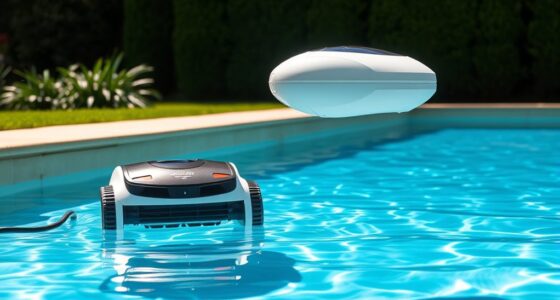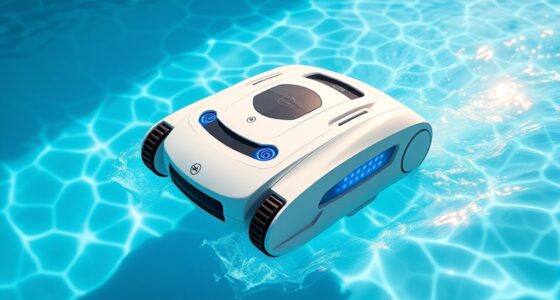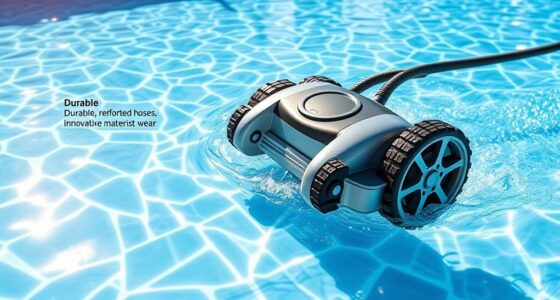Pressure pool cleaners work by using water pressure from your filtration system to move across the pool surface, scrubbing and collecting debris automatically. They connect to your pool’s hose and intake valve, harnessing high-pressure water to propel themselves with jets or turbines. Their system includes filters and nozzles that improve coverage while trapping debris. To find out more about how you can optimize their performance, keep exploring the details below.
Key Takeaways
- They use water pressure from the pool’s filtration system to power internal movement and cleaning actions.
- Hoses connect the cleaner to the pool’s pump, directing high-pressure water to generate propulsion.
- Nozzle systems and swivel joints improve maneuverability and coverage across the pool surface.
- Internal debris filters and collection chambers trap dirt, ensuring continuous cleaning without clogging.
- Sensors and navigation algorithms help detect obstacles and optimize movement patterns for thorough cleaning.
The Basic Structure of Pressure Pool Cleaners
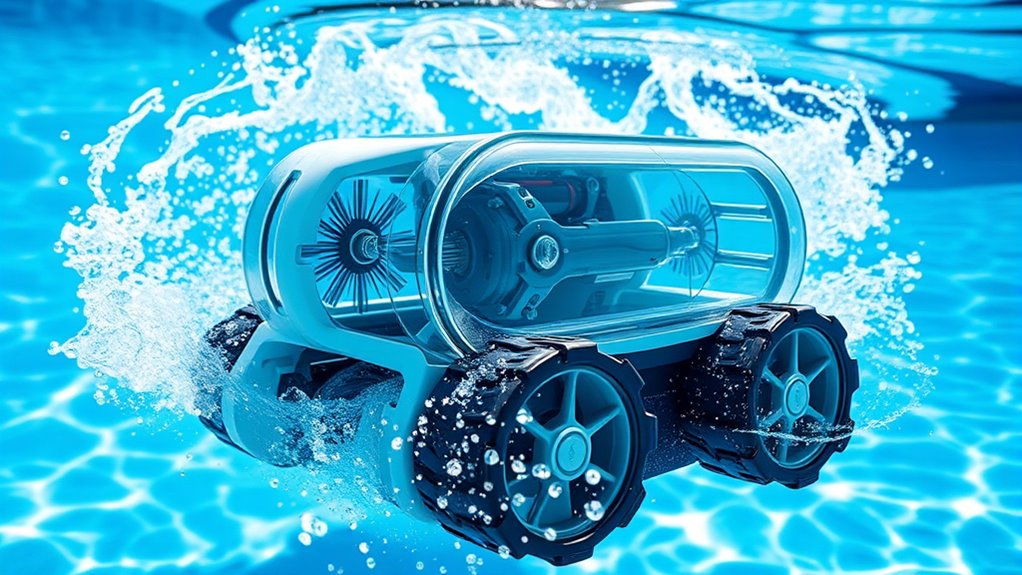
Pressure pool cleaners are designed with a straightforward yet effective structure that allows them to efficiently clean your pool. Their design minimizes disruptions to your pool’s chemistry by using targeted cleaning methods that reduce chemical imbalances. These cleaners typically feature durable plastic casings, hoses, and a nozzle system that directs water flow. This setup ensures energy efficiency, as they require less power compared to other cleaning options, helping you save on energy costs. The internal components are built to withstand exposure to pool chemicals, maintaining performance over time. By combining a simple, robust structure with optimized water flow, these cleaners effectively remove debris while keeping your pool’s chemistry stable and conserving energy. This design makes them a practical choice for maintaining a clean, balanced pool.
How Water Pressure Powers the Cleaner

The power behind a pressure pool cleaner lies in how water flow is harnessed to move and operate its components. When you turn on the system, water is pumped from the pool and directed through the pressure side hose and intake valve, creating a strong flow. This high-pressure water energizes the cleaner’s internal mechanisms, allowing it to navigate the pool and scrub surfaces effectively. Proper filter maintenance guarantees the water flows smoothly, preventing clogs that could reduce cleaning efficiency. Additionally, maintaining the correct suction power ensures the cleaner operates optimally and efficiently. Keep in mind, higher water pressure can increase energy consumption, so optimizing your system helps save electricity while maintaining performance. Additionally, selecting the right pressure ratings ensures optimal operation without overloading your equipment. Understanding how water pressure powers your cleaner allows you to better manage its operation and ensure your pool stays clean with minimal effort.
The Role of the Pressure Side Hose and Intake Valve
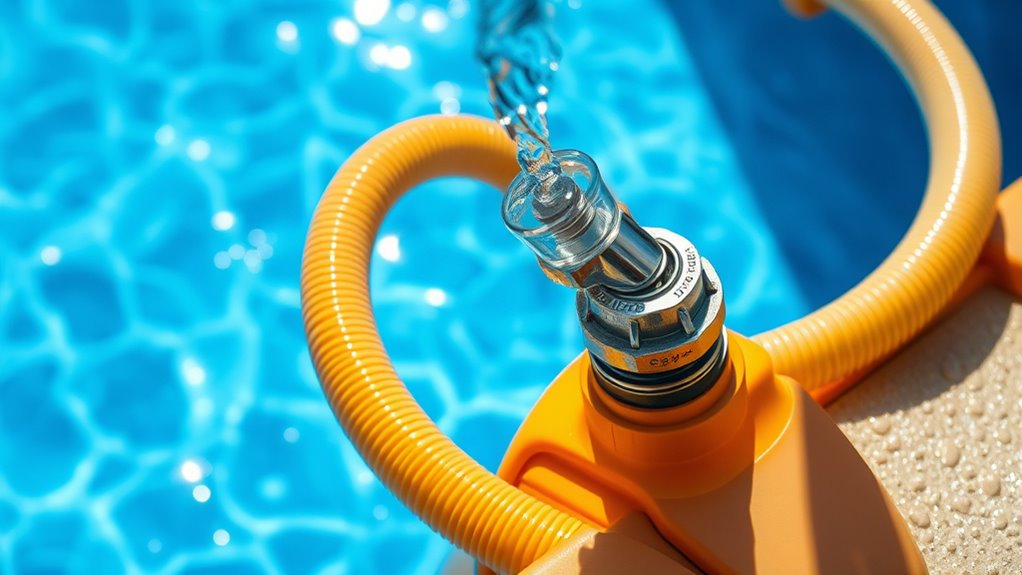
The pressure side hose connects your cleaner to the pool’s filtration system, ensuring water flows smoothly. The intake valve controls how much water enters the cleaner, affecting its performance. Understanding how these parts work together helps you keep your pressure pool cleaner functioning properly. Additionally, regular maintenance and system upgrades can optimize cleaning efficiency and prolong the lifespan of your equipment. Incorporating automation technologies can further enhance the efficiency of pool maintenance routines. Knowing the contrast ratio of your projector can significantly impact the clarity of images in your home cinema setup. For example, some pressure pool cleaners are designed specifically for black coated pools, which can influence how well the cleaner performs.
Hose Connection Mechanics
Understanding how the pressure side hose connects to your pool cleaner is essential for proper operation. The hose channels water pressure from your pump to power the cleaner’s movement, so secure connections are crucial. When attaching the hose, ensure it fits snugly onto the intake valve to prevent leaks that could disrupt water flow. Proper hose connection also helps maintain water chemistry; if connections are loose, debris or chemicals might bypass the system, affecting chemical treatments and water quality. Check for cracks or wear regularly, especially at connection points. A well-connected hose ensures consistent water flow, which improves cleaning efficiency. Additionally, understanding the somatic connection can offer insights into your personal growth and readiness for love, paralleling the importance of proper maintenance for your pool’s health. Regular inspection of the connection points can prevent issues before they arise, ensuring your pool remains clean and well-functioning. Proper hose maintenance and connection checks are vital for keeping your pool equipment in optimal condition and prolonging its lifespan. Remember, maintaining water chemistry and proper hose connections go hand-in-hand for ideal pool cleanliness and equipment longevity.
Intake Valve Function
Since the intake valve serves as the gateway for water flow into your pressure-side hose, it plays a vital role in your pool cleaner’s operation. When functioning properly, it directs water efficiently from the pool into the hose, creating the suction needed to pick up debris. Regular filter maintenance is essential because a clogged filter can reduce suction power, making the intake valve less effective. If debris blocks the valve or the hose, your cleaner won’t operate smoothly. You should check and clean the intake valve regularly to guarantee unobstructed water flow. Proper maintenance helps maintain maximum suction power, allowing your pressure pool cleaner to work effectively, keeping your pool clean and clear with less effort on your part. Additionally, understanding the safety of electric heated mattress pads can help ensure safe operation of electrical devices used in your pool area or home. Regular inspections of pool equipment components are also crucial for optimal function and safety, especially considering the filter replacement and the significant impact of payment processing security measures on overall safety protocols. Being aware of store hours for your local beauty supply stores can help you plan your maintenance and shopping needs efficiently.
Movement Mechanism and Navigation
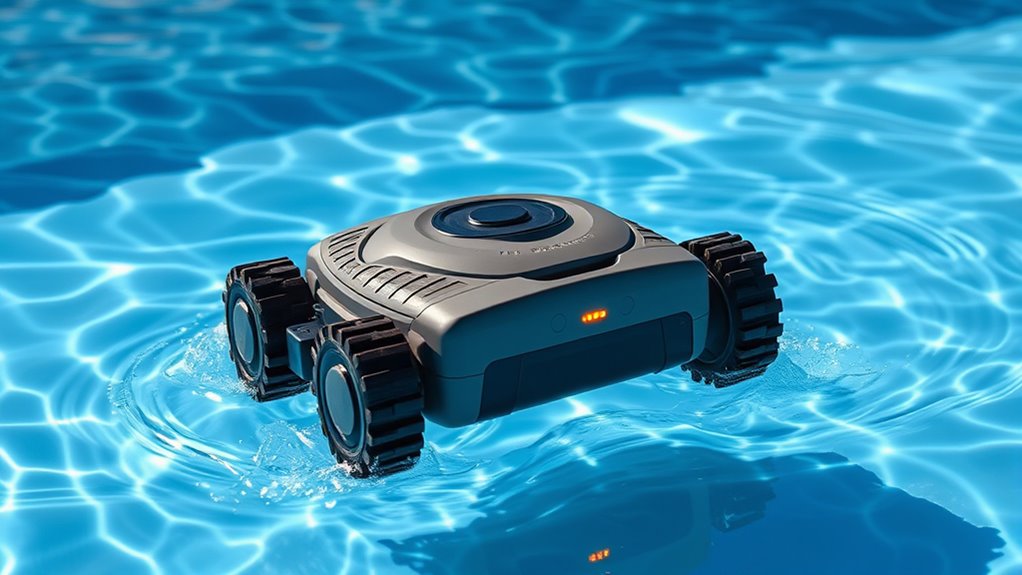
Your pressure pool cleaner uses different propulsion systems, like jet jets or wheels, to move across the pool floor. It relies on navigation algorithms to cover the entire surface efficiently, adjusting its path as needed. Obstacle avoidance methods help it detect and navigate around objects without getting stuck. Additionally, some models use sensors to detect the headphone jack types and adapt their movement accordingly.
Propulsion System Types
How do pressure pool cleaners move across the pool surface? They use different propulsion system types, such as turbines, jets, or wheels, to generate movement. These systems often rely on the pool’s water pressure, which powers the cleaner’s motion. Some cleaners have adjustable jets that direct water for better coverage, while others use wheels or tracks to navigate the surface. Proper water filtration is essential for maintaining ideal flow, ensuring the cleaner functions efficiently. Additionally, keeping your pool’s chemical balancing correct helps prevent debris buildup that could obstruct movement. The propulsion system determines how well your cleaner covers the pool, making thorough cleaning easier. Understanding these types helps you choose the right pressure cleaner for your pool’s size and shape. Regular maintenance, including filter protection, is vital to keep the system running smoothly and prolong the lifespan of your cleaner. Maintaining proper water flow is also crucial for optimal propulsion and cleaning performance. Moreover, selecting a system with adjustable jets can enhance coverage and adaptability to different pool conditions. Incorporating proper installation techniques can also improve the overall efficiency of your pressure cleaner. Additionally, choosing a system that aligns with your pool’s specific tuning requirements can optimize performance and energy use.
Navigation Algorithms Used
Pressure pool cleaners utilize various navigation algorithms to guarantee thorough coverage of the pool surface. They often follow systematic patterns, such as random bouncing or wall-following, to ensure all areas are cleaned efficiently. These algorithms help the cleaner adapt to different pool shapes and sizes while avoiding missed spots. Proper filter maintenance is essential for optimal performance, as clogged filters can hinder movement and cleaning effectiveness. Additionally, the navigation system’s design considers chemical compatibility to prevent damage from pool chemicals or cleaning agents. Some models use advanced algorithms that optimize movement paths, reducing cleaning time and increasing coverage. Navigation algorithms are key to maximizing efficiency and ensuring comprehensive cleaning. By intelligently maneuvering the pool, these cleaners minimize the need for manual intervention, ensuring your pool remains clean and well-maintained with minimal effort.
Obstacle Avoidance Methods
Obstacle avoidance in pressure pool cleaners relies on a combination of movement mechanisms and navigation systems to detect and navigate around obstacles effectively. Sensor technology plays a vital role by detecting objects in the pool’s environment, while pattern recognition helps the cleaner identify obstacles based on their shape and size. When sensors pick up an obstacle, the cleaner adjusts its path automatically, changing direction to avoid collisions. Some cleaners use pattern recognition to differentiate between debris and pool features, ensuring efficient cleaning without getting stuck. This combination allows for seamless navigation, enabling your pool cleaner to move around obstacles smoothly. By integrating sensor technology with intelligent pattern recognition, pressure pool cleaners maintain thorough coverage, even in complex pool layouts.
The Vacuum System and Debris Collection
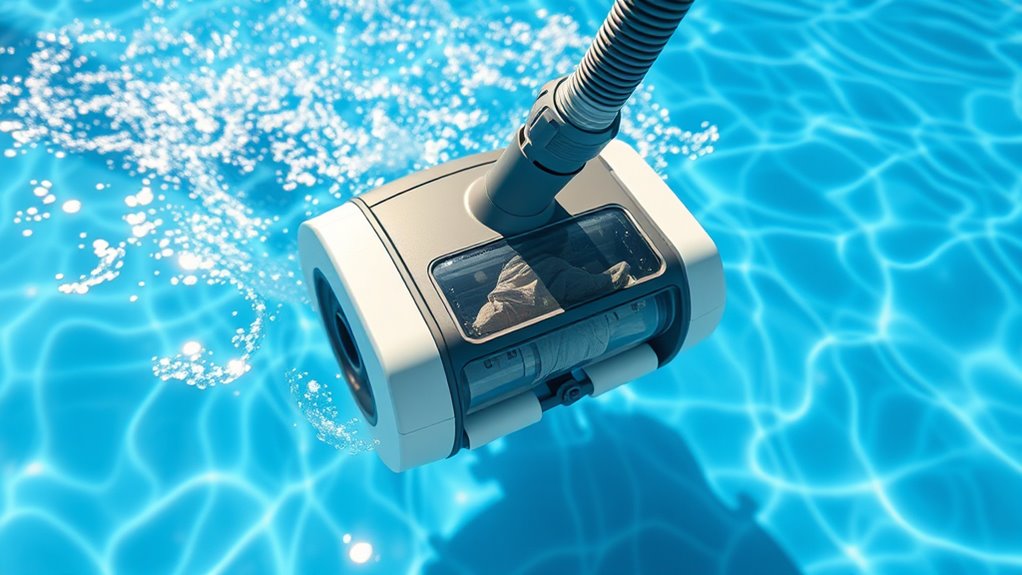
Ever wonder how pressure pool cleaners efficiently pick up debris from your pool? It all comes down to their vacuum system and debris collection process. These cleaners use powerful suction to lift dirt, leaves, and small particles from the pool floor and walls. Maintaining proper pool chemical balance helps prevent debris from sticking and clumping, making collection easier. Water temperature effects can influence debris size and buoyancy, impacting how well the vacuum system works. Cooler water might cause debris to sink faster, while warmer water can keep particles floating longer. The cleaner’s vacuum creates a strong, continuous flow that draws debris into its filter bag or chamber. Regularly checking and cleaning this debris collection system ensures top performance and keeps your pool spotless.
Components That Enhance Cleaning Efficiency
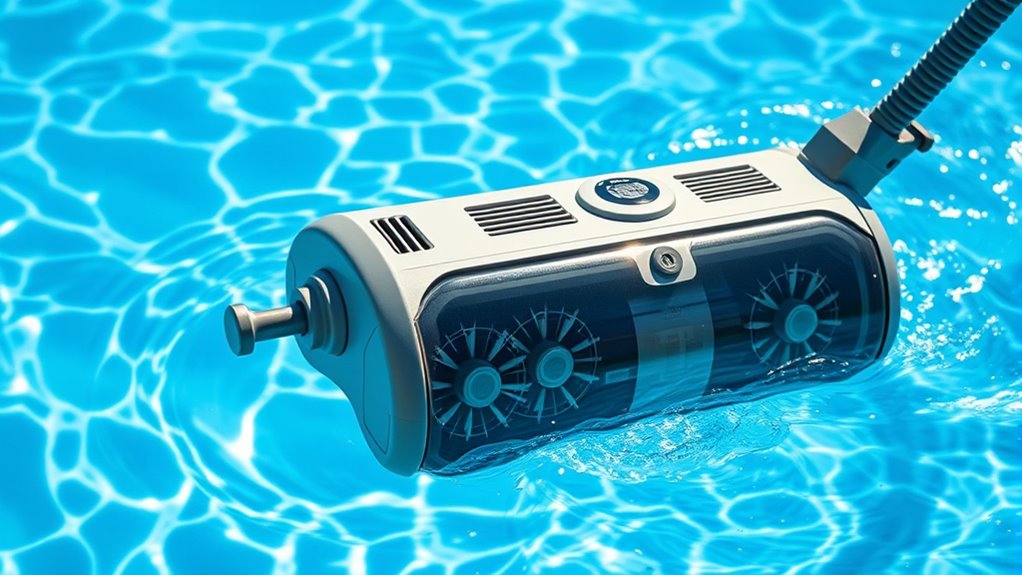
To maximize the cleaning power of your pressure pool cleaner, certain components are designed specifically to boost efficiency. One key element is the filter system, which traps debris and guarantees consistent water flow. Regular filter maintenance is crucial; cleaning or replacing filters prevents clogs that reduce cleaning performance. Additionally, the cleaner’s nozzle design and swivel joints help increase coverage and maneuverability, making cleaning more effective. Proper storage tips also play a significant role—store your cleaner in a dry, shaded area to prevent damage and maintain component integrity. Keeping components well-maintained and stored correctly ensures your pressure pool cleaner operates at peak efficiency, delivering cleaner water with less effort and fewer interruptions.
Benefits of Using Pressure Pool Cleaners
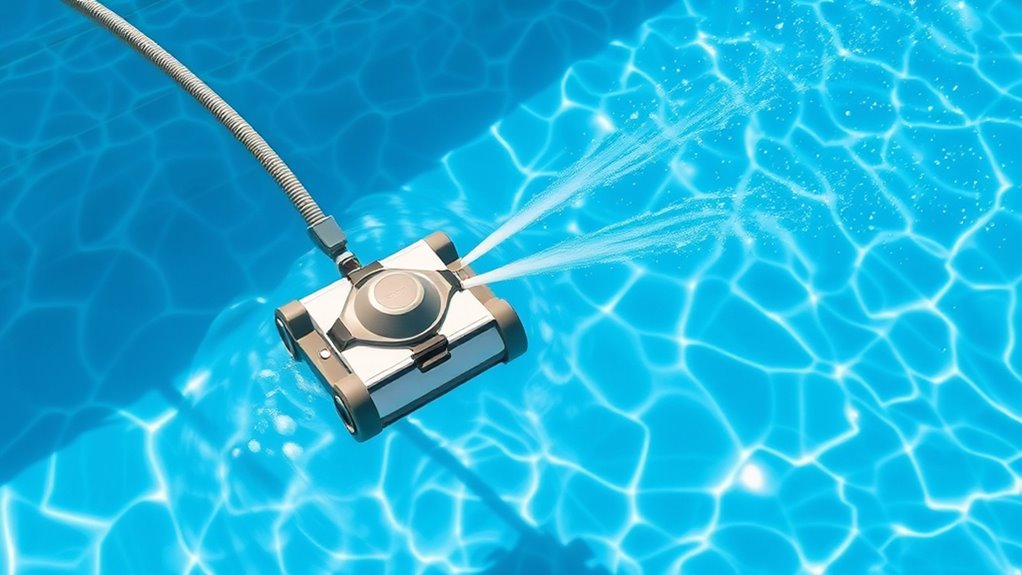
Using pressure pool cleaners offers numerous advantages that can save you time and effort. They efficiently remove dirt, debris, and algae, helping you maintain a clean pool with less manual work. By improving circulation, these cleaners promote a better chemical balance, reducing the need for frequent chemical adjustments and ensuring safer, clearer water. Additionally, a well-cleaned pool enhances lighting, allowing your pool lighting to shine brighter and create a more inviting atmosphere. Pressure cleaners reach difficult spots like corners and steps more effectively than manual methods. They also operate continuously, so your pool stays consistently clean. Overall, investing in a pressure pool cleaner simplifies maintenance, keeps your water balanced, and improves your swimming experience—all while saving you time.
Frequently Asked Questions
Can Pressure Pool Cleaners Handle Large Debris Effectively?
Pressure pool cleaners can handle large debris effectively thanks to their strong suction power and debris filtration system. They use high-pressure water jets to dislodge debris, which is then captured by their filtration system. While they excel at removing larger debris like leaves and twigs, you should guarantee your cleaner has a robust debris filtration setup. Regular maintenance keeps it working efficiently, ensuring your pool stays clean and debris-free.
How Energy-Efficient Are Pressure Pool Cleaning Systems?
Think of pressure pool cleaners as the silent sprinters in your backyard. They’re generally energy-efficient, using less power compared to traditional cleaners, which helps reduce your energy consumption. This efficiency not only saves you money but also lessens the environmental impact. While they work tirelessly to keep your pool pristine, their low energy use makes them a responsible choice for eco-conscious homeowners. You get a clean pool without draining your resources.
Are Pressure Cleaners Suitable for All Pool Types and Sizes?
You’ll find pressure pool cleaners suitable for many pool types and sizes, but manual operation might be necessary for larger or complex pools. They work well with various surfaces, yet you should check chemical compatibility to prevent damage. Smaller pools benefit from automatic cleaning, while larger ones may need additional tools. Consider your pool’s specific needs to determine if a pressure cleaner fits, ensuring effective and safe maintenance.
What Maintenance Is Required for Optimal Pressure Cleaner Performance?
To keep your pressure pool cleaner working well, you need to perform regular filter maintenance and pump inspection. Clean the filter regularly to prevent debris buildup that can hinder performance. Check the pump for any leaks or blockages, and guarantee all connections are secure. By staying on top of these tasks, you’ll maintain ideal cleaning efficiency and extend your pressure cleaner’s lifespan.
How Long Does a Typical Pressure Pool Cleaner Last?
Think of your pressure pool cleaner like a trusty bicycle—when well-maintained, it can last many seasons. Typically, it lasts 3-5 years with proper care. To maximize its lifespan, keep your pool’s chemical balance in check, ensuring no corrosion, and guarantee filter system compatibility to prevent strain. Regularly inspecting and cleaning your cleaner helps it run smoothly, so you get the most out of your investment.
Conclusion
Imagine your pool as a busy city street, and your pressure cleaner as a diligent delivery truck. Just like a well-oiled machine, it uses water pressure to zip around, collecting leaves and dirt along the way. With its efficient system, you’ll spend less time cleaning and more time enjoying your crystal-clear pool. Trust in its power—like a trusty delivery route, it keeps your pool spotless, so you can relax without worries.


